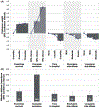Developing an instrument to assess patient preferences for benefits and risks of treating acute myeloid leukemia to promote patient-focused drug development
- PMID: 29565196
- PMCID: PMC8799376
- DOI: 10.1080/03007995.2018.1456414
Developing an instrument to assess patient preferences for benefits and risks of treating acute myeloid leukemia to promote patient-focused drug development
Abstract
Objective Acute myeloid leukemia (AML) is a progressive blood cancer with few effective treatment options. As part of a patient-focused drug development (PFDD) initiative led by the Leukemia and Lymphoma Society (LLS), this study sought to use a community-centered approach to develop and pilot an instrument to measure patient preferences for the benefits and risks of treating AML. Methods Instrument development was informed by a literature review, engagement with expert stakeholders (n = 12), engagement with community stakeholders, and pre-testing. A discrete-choice experiment (DCE), in which participants made choices between 16 pairs of hypothetical treatments, was developed with five attributes: event-free survival, complete remission, time in hospital, short-term side-effects, and long-term side-effects. A pilot test was conducted and analyzed using conditional logistic regression. Results are presented using relative attribute importance (RAI) scores. Results Patients with AML and caregivers were engaged in developing (n = 15), pre-testing (n = 13), and pilot testing (n = 26) the instrument. The pilot included patients with AML (n = 18) and caregivers of living or deceased patients with AML (n = 8). Participants had a mean age of 50 years (range =24-81), and were mostly college educated (n = 22), privately insured (n = 21), and employed (n = 13). Based on the DCE, complete remission was identified as the most important attribute (RAI =10), followed by event-free survival (3.7), time in hospital (2.8), long-term side-effects (2.3), and short-term side-effects (2.1). Conclusion The mixed-methods approach to PFDD was welcomed by all stakeholders and there was strong endorsement to implement this DCE as part of a national survey. Key points for decision makers The Leukemia and Lymphoma Society (LLS) initiated an independent effort to promote patient-focused drug development (PFDD). This study presents the development and piloting of a preference study as a first step in this initiative. Results of this pilot study were used to guide a PFDD meeting to discuss the lived experience of patients and caregivers affected by AML. Productive engagement by all patients, caregivers, and stakeholders throughout the process resulted in strong endorsement of the project's approach and recognition of the need to conduct a national study.
Keywords: Acute myeloid leukemia (AML); Community engagement; Instrument development; Stated preference.
Figures



References
-
- Grigoropoulos NF, Petter R, Van’t Veer MB, et al. Leukaemia update. Part 1: diagnosis and management. BMJ 2013;346:f1660. - PubMed
-
- Khwaja A, Bjorkholm M, Gale GE, et al. Acute myeloid leukaemia. Nature Rev Dis Primers 2016;2:16010. - PubMed
-
- DeSantis CE, lin CC, Mariotto AB, et al. Cancer treatment and survivorship statistics, 2014. CA Cancer J Clin 2014;64:252–71 - PubMed
-
- Döhner H, Estey EH, Amadori S, et al. Diagnosis and management of acute myeloid leukemia in adults: recommendations from an international expert panel, on behalf of the European LeukemiaNet. Blood 2010;115:453–74 - PubMed
Publication types
MeSH terms
Grants and funding
LinkOut - more resources
Full Text Sources
Other Literature Sources
Medical
Research Materials
